Winning cover letter for a grant proposal guide
Learn to write a strong cover letter for a grant proposal with a proven template and tips to boost your funding odds.
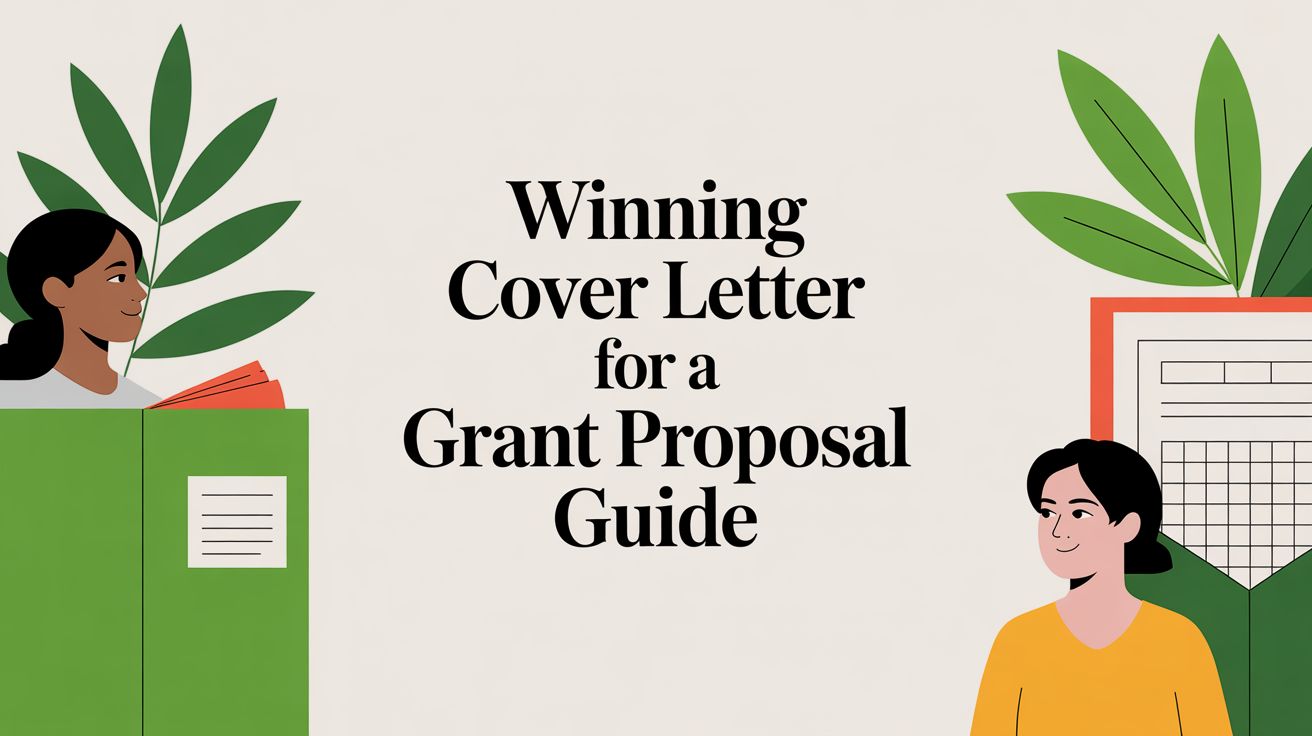
A grant cover letter is your first—and often best—chance to make a genuine connection with a funder. It’s more than just a formality; it's a one-page introduction that sets the stage for your entire proposal. Think of it as a professional handshake, offering a concise and personal preview of your project and why it matters to them before they ever lay eyes on your full application.
Your First Impression: The Grant Cover Letter
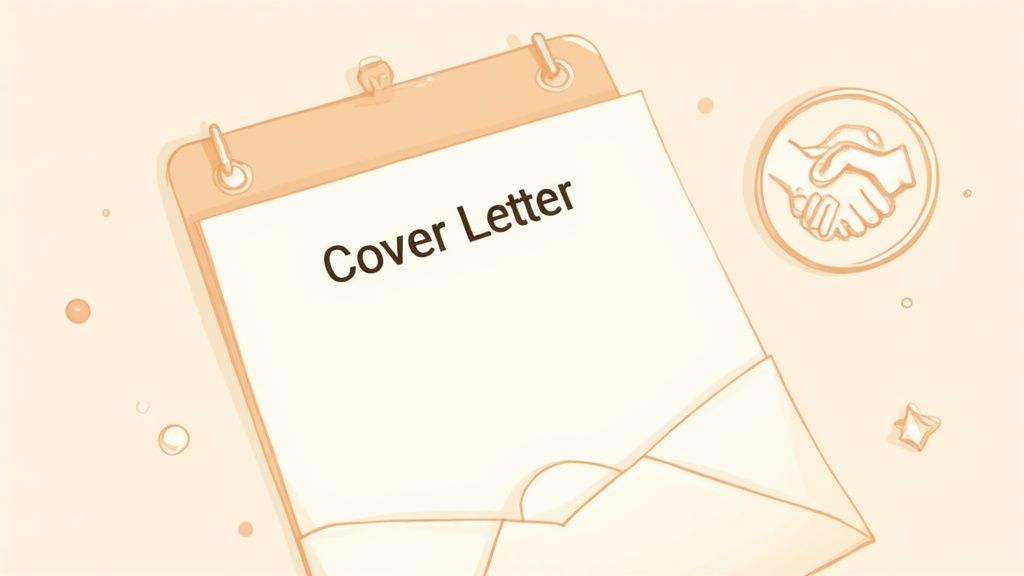
Before a program officer even thinks about diving into your detailed, data-packed proposal, your cover letter has already done some heavy lifting. Its job is to convince a busy reviewer that your project isn't just another application in the pile—it's an opportunity perfectly aligned with their foundation's mission and well worth their time.
It’s important not to confuse a cover letter with a letter of inquiry (LOI). An LOI is a preliminary step to see if a funder is interested in learning more. In contrast, the cover letter goes with the full proposal, either because you've been invited to apply or because the foundation accepts unsolicited proposals. If you want to dig into the nuances, check out our guide on how to write a grant inquiry letter.
Why It Matters More Than You Think
In a competitive funding environment, your cover letter provides a much-needed human touch. It’s where you start telling your story, showcasing your professionalism, and proving you’ve done your homework. The impact is real; a 2015 survey revealed that proposals with a cover letter had a 15-20% higher success rate than those without. That's a significant edge.
A great grant cover letter doesn’t just introduce the proposal; it starts building the relationship. It’s your chance to speak directly to the reviewer, showing them you understand their goals and are the right partner to help achieve them.
What Your Letter Really Needs to Do
Your cover letter has a few critical jobs to do, all of which strengthen your application. It’s your chance to:
- Make a Direct Connection: Addressing your letter to a specific person by name immediately personalizes the communication.
- Summarize the "Why": It clearly and quickly states the problem you're solving, your proposed solution, and exactly how much funding you need. No beating around the bush.
- Show You've Done Your Homework: This is where you explicitly connect the dots between your project and the funder's stated priorities.
- Provide a Quick Guide: The letter should briefly list the documents included in the package, acting as a helpful roadmap for the reviewer.
When done right, your cover letter makes the reviewer's job easier and frames your proposal in the most favorable light from the very beginning.
To help you get started, here's a quick breakdown of the essential components that make a grant cover letter truly effective.
Essential Components of a Grant Cover Letter
Putting these elements together thoughtfully ensures your cover letter doesn't just introduce your proposal—it champions it.
Anatomy of a Winning Grant Cover Letter
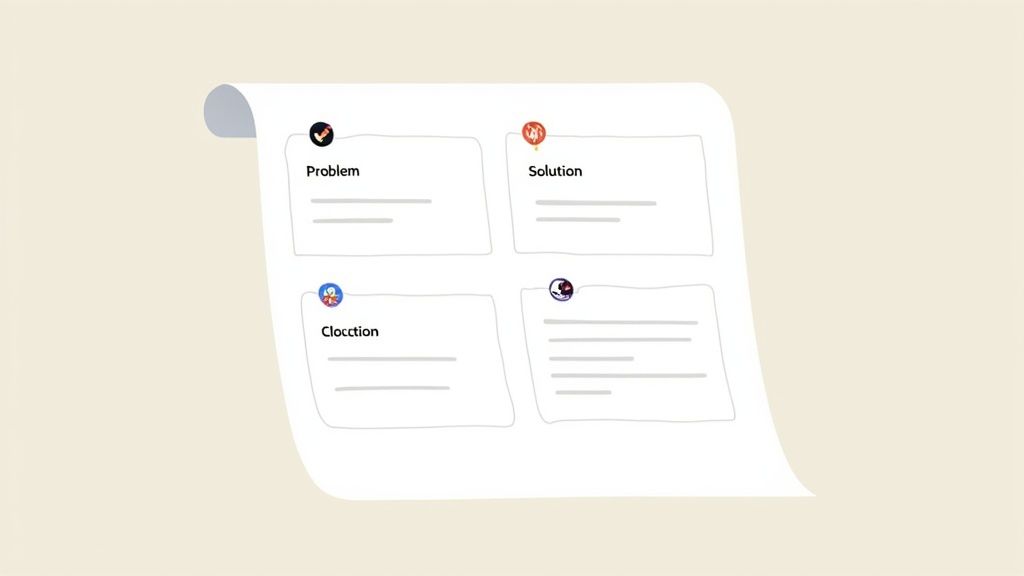
Let's get practical and break down what really makes a cover letter for a grant proposal work. Think of it less like a formal introduction and more like a firm, confident handshake. It has three distinct parts: the hook, the body, and the closing. Each one has a specific job, and when they work together, they make a powerful first impression.
This isn’t the place to rehash every detail from your full proposal. Your real goal is to frame the most important information in a way that feels personal and immediately shows the funder why you're a perfect match.
Crafting a Hook That Connects Instantly
Your opening paragraph is your one shot to make the reviewer sit up and pay attention. You’ve got maybe two sentences to prove this proposal is worth their time. A generic "To whom it may concern" style opening is the fastest way to land in the "maybe later" pile.
Instead, you need to connect your project to the funder's mission right out of the gate. The best hooks I've seen are direct, have clearly done their homework, and speak the funder's language.
Try one of these approaches to start strong:
- Lead with Shared Values: Reference a specific priority you saw on their website or a recent initiative they launched. This shows you're paying attention.
- Use a Compelling Statistic: Hit them with a powerful data point that perfectly frames the problem you're solving.
- Reference a Prior Conversation: If you’ve spoken with a program officer, mention it! It immediately re-establishes a personal connection.
The first paragraph of your cover letter should be short, succinct, and powerful. Introduce your organization, state the amount you are requesting, and clearly articulate why you are asking them for this specific amount.
For example, a weak opening is something like, "We are writing to request funding for our literacy program." It's forgettable.
A much stronger, more targeted opening sounds like this: "Inspired by the [Funder's Name] Foundation's commitment to closing the early education gap in our city, the Literacy for All Project respectfully requests $50,000 to expand our proven reading intervention program to three under-resourced elementary schools." See the difference? It's specific and shows you know who you're talking to.
Building a Concise and Powerful Case for Support
The body of your letter is your mini-proposal—usually just one or two punchy paragraphs. This is where you quickly lay out the problem, your solution, and the impact you’ll have. You don't have room for fluff; every single word needs to earn its place.
Your job here is to give the reviewer a compelling snapshot of your full proposal, just enough to make them eager to dive into the details.
Make sure the body of your letter hits these three points:
- The Problem: Briefly describe the critical need. If you have local data, use it. It makes the problem feel real and urgent.
- Your Solution: Explain what you do and what makes your approach the right one. Is it innovative? Proven? Scalable? Tell them.
- The Impact: State the measurable outcomes you'll achieve. Crucially, connect those outcomes directly back to the funder's own stated goals.
Here’s a quick comparison to show what I mean:
The specific approach uses hard numbers and clear outcomes. That kind of language screams competence and shows you have a solid plan, which is exactly what funders want to see.
Writing a Confident Closing and Call to Action
The final paragraph of your cover letter for a grant proposal should leave the reviewer feeling confident and clear on what's next. It’s your chance to wrap things up professionally.
Don’t be passive here. A simple "Thank you for your consideration" feels weak. You want to gently guide the reviewer toward the next step.
A strong closing should always include:
- A quick, enthusiastic line about the potential for partnership.
- A clear list of what’s attached ("The full proposal, budget, and our 501(c)(3) determination letter are attached for your review.").
- Your direct contact information so they don’t have to hunt for it.
- A forward-looking statement about your eagerness to talk more.
For instance, you could end with something like this: "We are confident that our Youth STEM Initiative aligns perfectly with your goals of fostering the next generation of innovators. The full proposal is enclosed for your review. I can be reached at (555) 123-4567 and welcome the opportunity to discuss how we can partner to make a lasting impact."
This kind of closing is professional, proactive, and makes it incredibly easy for the funder to move forward. It ends the letter on a note of mutual respect and shared purpose.
How to Align Your Pitch with Funder Priorities
Sending a generic, one-size-fits-all cover letter is the fastest way to land your proposal in the "no" pile. Funders can spot a boilerplate request from a mile away, and it tells them one thing loud and clear: you haven't done your homework.
To truly stand out, your letter needs to act like a mirror, reflecting the funder's own mission, language, and recent priorities right back at them. This goes far beyond just name-dropping a program they funded once. It's about showing you deeply understand what drives their giving, and that begins with solid research before you ever write a single word.
Digging Deeper Than the Website
Think of yourself as a detective. Your mission is to uncover the nuanced story behind the funder's giving patterns and current interests. A fantastic cover letter for a grant proposal is built on specific insights, not vague assumptions.
Here's where to find the clues that will make your letter shine:
- Annual Reports & Form 990s: These are absolute goldmines. Look for patterns. Who did they fund last year? For how much? What kinds of projects get the most support?
- Press Releases & Newsletters: These documents tell you what the foundation is excited about right now. Pay close attention to the specific keywords and phrases they use to describe their wins.
- Program Officer Profiles: Whenever possible, learn about the people who will actually read your proposal. Understanding their backgrounds can help you frame your project in a way that connects with them on a more personal level.
This level of detail is what allows you to go from a generic line like, "Your foundation supports youth education," to a much more powerful hook: "We were inspired by your recent $50,000 investment in project-based STEM learning, a commitment that directly mirrors our own hands-on approach to closing the achievement gap." See the difference?
Speaking Their Language
Once you've gathered your intel, it's time to weave it into your letter. The key is to mirror their language without sounding like you just copied and pasted it. If a funder constantly talks about "community-led solutions" or "scalable impact," those are the exact phrases you should use to describe your own work.
A powerful technique is to directly quote a phrase from the funder’s mission statement and explicitly connect it to your project's main goal. This creates an immediate, undeniable link between your work and their core purpose.
For instance, if their mission is "to foster resilient and equitable communities," your letter could state: "Our project directly advances this mission by creating a 'resilient and equitable' workforce pipeline for underserved residents." This simple move shows you’re not just asking for a check; you're positioning your nonprofit as the perfect partner to help them achieve their own goals.
Framing Your Project to Match Their Goals
The final piece of the puzzle is framing. You aren't changing your project, but you are changing how you present it. Every program has multiple facets; your job is to shine a spotlight on the one that aligns most perfectly with the funder you're approaching.
Imagine your nonprofit runs an after-school arts program. You could frame it in several ways:
- For an Education Funder: Emphasize how the program boosts academic performance, citing data on how arts education improves test scores and graduation rates.
- For a Youth Development Funder: Highlight the program's role in building self-esteem, teamwork, and critical leadership skills in young people.
- For a Community Safety Funder: Frame the program as a vital, positive alternative for at-risk youth, showcasing its impact on reducing juvenile delinquency.
The project is the same, but the narrative is tailored. You are connecting the dots for the reviewer, making it incredibly easy for them to see how funding you helps them meet their specific objectives. This is a critical step in building a strong case, starting with your problem description—something you can learn more about by crafting a powerful needs statement.
By keeping your letter to 3-4 concise paragraphs and thoughtfully mirroring the funder's language, you transform a simple request into a compelling argument for a strategic partnership.
Real-World Examples from Successful Proposals
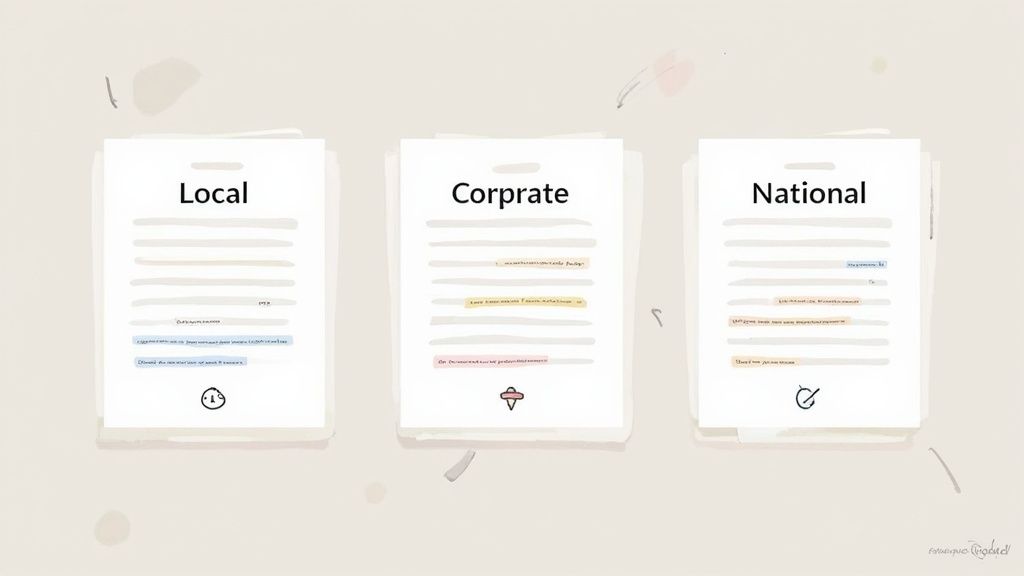
Theory is great, but seeing it in action is what makes everything click. Let’s move past the abstract and get our hands dirty by dissecting a few real-world examples of a cover letter for a grant proposal.
By breaking down letters written for different kinds of funders, you can see how the core principles we’ve discussed—like personalization and strategic alignment—actually play out. We’ll look at annotated examples for three common funder types. Pay close attention to the subtle shifts in tone, focus, and language. Each letter has the same goal, but the approach is carefully tailored to hit the right notes with its audience.
Example 1: The Local Community Foundation
Community foundations are all about local impact. They want to fund projects that directly benefit the neighbors and communities they serve. This means your cover letter needs to be grounded in local data, shared values, and a genuine sense of partnership.
Scenario: A nonprofit called "Riverbend Youth Center" is seeking $25,000 from the "Maplewood Community Foundation." The foundation has a stated priority of improving educational outcomes for local youth, which is a perfect match for the center's after-school tutoring program.
Why this works: The letter doesn't waste a second establishing a shared connection. It speaks the foundation's language by using local statistics to build urgency and frames the nonprofit as a community partner, not just an applicant. The ask is direct, and the proposed outcomes mirror the foundation’s own goals.
Here’s a breakdown of how they did it:
Example 2: The Corporate Sponsor
When you’re writing to a corporate funder, you need to think a little differently. They’re often looking for partnerships that align with their brand values, offer employee engagement opportunities, or generate positive PR. Your cover letter needs to speak to mutual benefits and a shared vision.
Scenario: "GreenScapes," an environmental nonprofit, is asking for $75,000 from "InnovateCorp," a tech company with a public commitment to sustainability.
The language here shifts from community partnership to strategic alignment. GreenScapes has to show InnovateCorp how funding this project helps the company meet its own corporate goals.
Here are a few key elements from their letter:
- Opening with Alignment: "InnovateCorp’s leadership in corporate sustainability is a model for our city. In that spirit, GreenScapes requests $75,000 to launch our 'Tech for Trees' initiative, a project that directly supports your goal of investing in urban green spaces."
- Highlighting Mutual Benefit: The letter points out potential volunteer days for InnovateCorp employees and mentions how the project will be publicly recognized, giving the company a clear brand-building win.
- Using Business-Friendly Language: Words like "investment," "return on investment" (framed as community impact), and "strategic partnership" are used to resonate with a corporate mindset.
- Data-Driven Impact: "This investment will enable the planting of 500 native trees, offsetting an estimated 24 metric tons of CO2 annually and increasing green space in a community where 80% of your local employees live." This brilliantly connects the environmental impact directly back to the company’s own workforce.
Example 3: The National Philanthropic Organization
National foundations tend to focus on big-picture, systemic problems. They want to see an evidence-based model that can be scaled up and replicated elsewhere. Your cover letter has to prove you’re thinking beyond your own backyard.
Scenario: "MindfulPath," a mental health organization, is requesting $250,000 from the "Wellness for America Foundation" to expand its proven mental health curriculum for high school students.
Key Takeaway: For a national funder, your local project must be presented as a pilot or a model for a solution that could work anywhere. You have to show you understand the national conversation around your issue and have a vision for broad impact.
Here's how MindfulPath made its case:
- Starts with a National Statistic: Their letter opened by referencing a major national study on teen anxiety, immediately establishing the project's relevance on a larger scale.
- Highlights the Evidence-Based Model: It emphasized that their curriculum was "validated by a three-year study with Smithson University," which signals the kind of credibility and proven track record national funders demand.
- Focuses on Scalability: The language centered on creating a "replicable, cost-effective model" and included a plan to develop a "digital toolkit" for other organizations across the country to use. This showed the funder their investment would have a ripple effect.
- Connects to the Funder's Own Work: The letter cleverly mentioned a recent report published by the Wellness for America Foundation, proving they had done deep research and were directly aligned with the funder's thought leadership.
By studying these different approaches, you can see how a powerful cover letter for a grant proposal is never a one-size-fits-all document. If you want to dive deeper into the full structure of a winning application, you can explore a complete grant proposal example for a non-profit on our blog. Each example we've covered here uses the same building blocks but tailors the message, tone, and evidence to perfectly match the funder's unique priorities.
Common Cover Letter Mistakes to Avoid
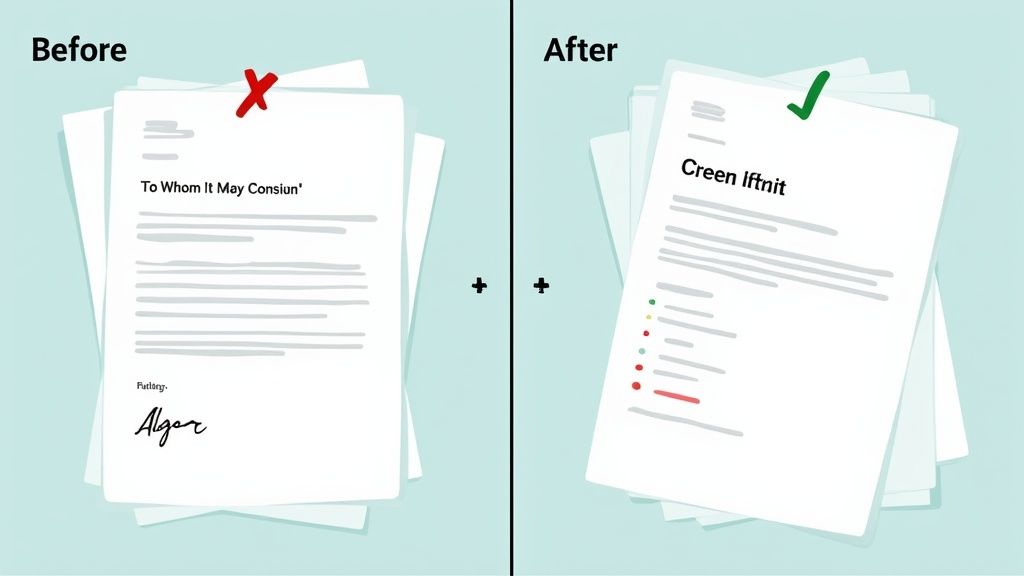
Sometimes, writing a killer cover letter for a grant proposal is less about what you put in and more about what you leave out. I’ve seen countless strong proposals get sidelined because of a few simple, avoidable mistakes in the very first document a program officer reads.
These aren't complex errors, but they can signal a lack of attention to detail and undermine your credibility before the reviewer even gets to the heart of your project. Let's walk through the most common traps and how you can sidestep them to make sure your proposal gets the fair reading it deserves.
The Generic and Impersonal Greeting
Nothing says "form letter" faster than "To Whom It May Concern." This is probably the most common mistake I see, and it immediately tells the funder you haven't done your homework. A generic greeting feels cold and suggests you're just mass-mailing proposals.
Take the extra ten minutes to find the right person. Scour the funder's website, look at their staff directory, or check their annual report. A quick search on LinkedIn for the foundation’s grants manager or program officer can be a goldmine.
- Instead of this: "To Whom It May Concern,"
- Do this: "Dear Ms. Evelyn Reed,"
What if you genuinely can't find a name? Don't default to a generic greeting. Aim for a specific title instead.
- A good last resort: "Dear Grants Review Committee,"
Exceeding the One-Page Rule
This is a non-negotiable rule in the grant world. Your cover letter must fit on a single page. Period. Program officers are swamped, often reading hundreds of applications. Handing them a multi-page letter is an instant red flag.
It signals that you might struggle with being concise, a crucial skill for grant reporting and management. Keep it tight. Your letter should be a powerful, skimmable summary that respects the reviewer's time and shows you can distill complex ideas into their most compelling form.
Think of your cover letter as the trailer, not the full movie. It needs to give a powerful preview that makes them want to see more, not rehash every single scene from your proposal.
Burying the Funding Request
Don't be shy about your ask. I've seen letters where the funding amount is buried deep in the third paragraph or, even worse, not mentioned at all. This forces the reviewer to hunt for the most critical piece of information and can make you seem hesitant or disorganized.
State your request clearly and confidently, right up front. It should be in your opening paragraph.
- Weak: "We are writing to seek support for our new community arts program."
- Strong: "Our organization respectfully requests a grant of $45,000 to launch our new community arts program for at-risk youth."
This direct approach provides immediate context and frames the entire letter with a clear purpose.
Overloading with Jargon and Acronyms
You live and breathe your work, but the person reading your letter doesn't. Filling your writing with technical jargon, industry-speak, or internal acronyms is a surefire way to confuse and alienate your reader. Your project might sound impressive to you, but to an outsider, it can just seem inaccessible.
The goal is clarity and connection. Use plain, direct language that anyone can understand. If an acronym is absolutely necessary, make sure you spell it out the first time you use it.
To help you double-check your own letter, here's a quick rundown of these common slip-ups and how to fix them.
Common Cover Letter Pitfalls vs Best Practices
By using this table as a final checklist before you hit send, you can catch these simple errors and ensure your cover letter makes the professional, compelling first impression your project needs.
Frequently Asked Questions
When it comes to grant cover letters, even seasoned grant writers have questions. Let's face it, the unwritten rules can sometimes feel as important as the written ones. Getting these details right is your first step toward making a great impression, so let's clear up a few of the most common sticking points.
How Long Should a Grant Proposal Cover Letter Be?
Keep it to one page. Period. I can't stress this enough.
Program officers are swamped, and a letter spilling onto a second page is a red flag. It suggests you can't be concise, which might make them worry about how you'll handle project reporting down the line.
Your sweet spot is three or four focused paragraphs. Use a clean, professional font (think Arial or Times New Roman, size 11 or 12) and don't be afraid of white space. An easy-to-scan page is a gift to a busy reviewer.
Should I Still Send a Cover Letter If It's Not Required?
My answer is almost always yes. The only exception is if the guidelines specifically say, "Do not include a cover letter."
Think of it as a firm, professional handshake before you sit down to talk business. It’s your chance to frame the conversation and introduce your project with a personal touch that a mountain of forms and attachments just can’t replicate.
What if you're submitting through an online portal with no field for a cover letter? Simple. Combine your cover letter and proposal into a single PDF, with the letter as the very first page. It’s a smart, proactive move that shows you're thorough.
A cover letter is your chance to start the conversation on your own terms. It’s a strategic tool to guide the reviewer’s first impression, making it a valuable addition even when not technically required.
Who Should I Address the Cover Letter To?
"To Whom It May Concern" is the kiss of death in grant writing. It immediately tells the funder you haven't done your homework.
Take the time to find a name. A letter addressed directly to the right program officer or grants manager shows respect and signals that you see this as a potential partnership, not just a transaction. Dig through the foundation's website, look at their staff list, or even check LinkedIn.
If after all that sleuthing you still come up empty, a title is your next best bet. "Dear Grants Review Committee" or "Dear Program Officer" works in a pinch, but it should always be your last resort.
Ready to stop guessing and start winning? Fundsprout uses AI to help you find the perfect funding opportunities and write compelling proposals faster. Our RFP analyzer and writing assistant turn complex requirements into clear outlines and polished narratives, giving you more time to focus on your mission. Discover how our tools can streamline your entire grant writing process.
Try 14 days free
Get started with Fundsprout so you can focus on what really matters.
